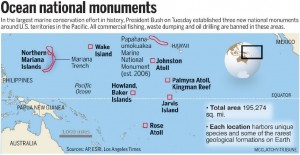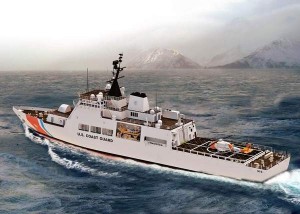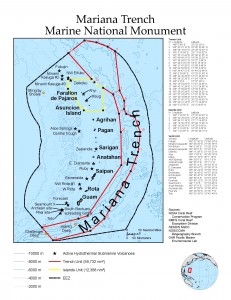 Here’s a challenge for my friends in the media, my resident China-Watchers, and those passers-by of the high intelligence set: How is China responding–if at all–to the White House’s quiet June 16 imposition of American control over millions of kilometers of strategic seabed?
Here’s a challenge for my friends in the media, my resident China-Watchers, and those passers-by of the high intelligence set: How is China responding–if at all–to the White House’s quiet June 16 imposition of American control over millions of kilometers of strategic seabed?
I’m willing to bet that this expansion of American authority in the Deep Pacific is galling for China. On one hand, China’s President Xi Jinping, is trying every tactic short of outright war to silence pesky neighbors and cement a claim to a mere 1.7 million square kilometers of grubby South China sea real estate, while, on the other, President Barack Obama, at the stroke of a pen–and with no international uproar–expanded the boundaries of the Pacific Remote Islands National Monument and made over 2.0 million square kilometers of strategic seabed off-limits to China’s resource-extraction-minded economic interests.
I can only assume that Sun Tzu would be amused by the U.S. President’s step, saying to his frustrated Chinese students, “well, see, that’s power.”
 From what I can gather, China’s frustration is almost palpable (how dare America overshadow China’s mid-June roll-out of four more South China Sea-bound petrochemical exploration rigs!).
From what I can gather, China’s frustration is almost palpable (how dare America overshadow China’s mid-June roll-out of four more South China Sea-bound petrochemical exploration rigs!).
Here’s the reaction from China’s Global Times:
“….Uncle Sam has struck a rather novel maneuver by announcing the establishment of a large marine preserve and the international community has yet to figure out which international law it is based on. Washington has not ratified the United Nations Convention on the Law of the Sea (UNCLOS). Hence, it appears that it is seeking to safeguard its rights and interests within its 200-mile exclusive economic zone, a right enjoyed by signatories to UNCLOS. Whether Washington has other purposes remains to be seen.
Protecting sea areas is a highly noble justification, which, nevertheless, should be achieved via legal means. It seems that the US intends to break through some restrictions with the excuse of “protecting the ocean” to further expand and intensify its presence in the Pacific Ocean….
And:
….While it may prove difficult, China should prompt the international community to demand the US interpret this decision. After all, the preserve will be established on the high seas instead of in its exclusive economic zone. It needs to tell the rest of the world what international laws it is observing….
…Now, there is little influence over Beijing, but it will probably wield negative impacts in the future.
US military bases and the islands it controls are scattered across the Pacific Ocean. Therefore it must aim to tighten the screws on the whole ocean by drawing up plans around them. If the US can arbitrarily change the attributes of high seas and the international community leaves it unchecked, it will certainly do harm to China’s interests.”
 Judging from this snap reaction, the expansion of the Pacific Remote Islands Monument may actually be quite a foreign policy coup. If you listen closely, you can almost hear China’s policymakers stamping their feet in vexation.
Judging from this snap reaction, the expansion of the Pacific Remote Islands Monument may actually be quite a foreign policy coup. If you listen closely, you can almost hear China’s policymakers stamping their feet in vexation.
In geopolitical terms, this growth of America’s Pacific National Monuments is a fascinating little gambit–we’re positioning the Pacific Remote Islands National Monument to be an altruistic act–a measure safeguarding some of the Pacific’s most pristine fisheries–fisheries that China will increasingly rely upon–while, at the same time, securing strategic island outposts in the Deep Pacific. So as China protests–and, interestingly enough–pokes the US about failing to recognize international legal norms like UNCLOS, and makes rumblings about how we are simply claiming the “high seas” rather than securing our EEZ–we’ve put down a legal marker for future enforcement
It’s certainly has a tiny whiff of being a dual-use initiative–Building on President Bush’s 2009 effort to protect biologically valuable Pacific Island resources like Kingman Reef, Palmyra atoll, Howland Island, Baker Island, Jarvis Island, Johnston Atoll and Wake Island, President Obama extended the National Monument protections to the EEZ limit–which for decidedly military places like Wake, and potentially re-militarizable Johnston Atoll, this measure wraps, essentially, a 200-mile exclusion zone around the islands, foiling overwatch by all manner of militarized “faux tuna fishermen” and other odd AGI trawlers or third-rate naval militia types–while also protecting isolated biologically-sensitive sea features from exactly the kind of friendly, homesteading-minded landings that started all the current trouble out at the South China Sea’s Mischief Reef.
It’s nice to see that America is starting to value islands again.
A few things to note is that Rose Atoll (the easternmost part of American Samoa) seems to have been left out of this expansion–probably to avoid irking nearby Samoa (to the West) and Niue (to the South).
The other item to note is that other countries are reading the tea leaves from the South China Sea and are following the US example of identifying their territory and enshrouding it under legal precedent. According to the Washington Post:
“Other countries are moving ahead with their own marine reserves. The British Government is considering creating a sanctuary around the Pitcarin Islands—an area in the Pacific inhabited by descendants of the mutineers from the HMS Bounty and their Tahitian companions—according to people briefed on the decision.
Anote Tong, president of the small Pacific island nation of Kiribati, announced Monday that he will close an area roughly the size of California to commercial fishing by the end of this year. “It’s our contribution to humanity,” Tong said in an interview.”
 The key test is, of course, can the US can actually muster the ISR and patrol resources to actually maintain awareness of this vast new “territory”? If I were the Commandant of the Coast Guard, I’d be torn between sighing over another unfunded mandate, or cheering that I could turn this initiative into a few more–and much needed–Offshore Patrol Cutters. I would also suggest working with Australia to bulk up the Pacific Patrol Boat Initiative.
The key test is, of course, can the US can actually muster the ISR and patrol resources to actually maintain awareness of this vast new “territory”? If I were the Commandant of the Coast Guard, I’d be torn between sighing over another unfunded mandate, or cheering that I could turn this initiative into a few more–and much needed–Offshore Patrol Cutters. I would also suggest working with Australia to bulk up the Pacific Patrol Boat Initiative.
The other piece that is left hanging is the state of the protections for the Mariana Trench–another area that was put “off limits” by President Bush, as the territorial issues and interests of CNMI and other regional neighbors need to be taken into account. But the Mariana Trench isn’t your typical EEZ that extends from a surface feature, but a subsurface feature that looks to be within several other national EEZs.
And then, of course, there’s the big Pacific prize, Antarctica. Nobody is daring to discuss that “elephant in the room”.
It’s somewhat sad to see the last bits of free, truly lawless areas of the world start falling under administrative rules and regulations. But it’s all a somewhat healthy process–I suspect that the ongoing South China Sea experience with China is demonstrating two things–good fences make good neighbors and prevention of encroachment is far easier to handle than rolling it back.
